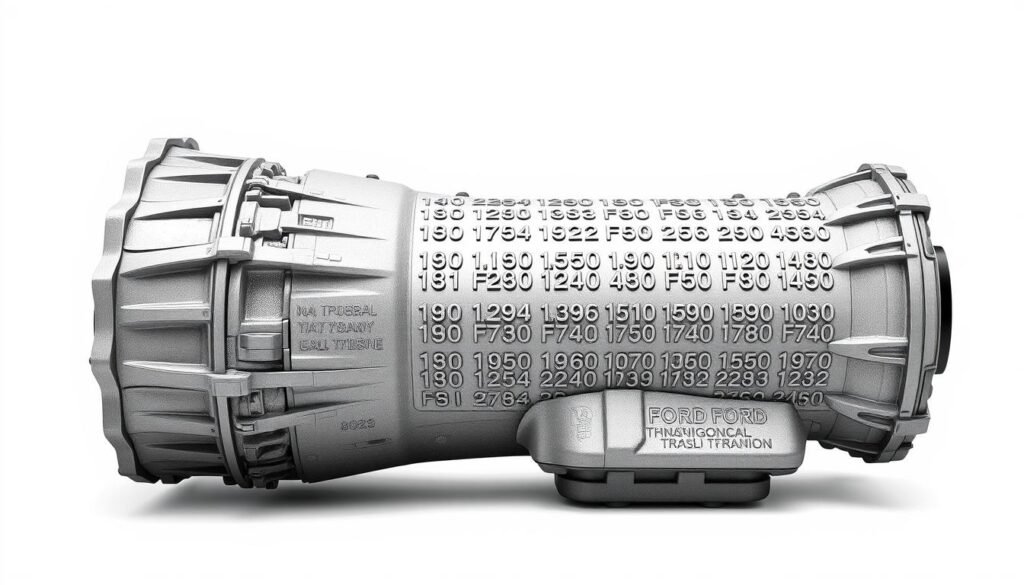Decoder Ford Transmission Identification Codes Exclusive Guide
What are Decoder Ford transmission identification codes? They are keys to knowing your vehicle’s transmission specs.
This guide will help you understand them. By learning these codes, you can make smart choices about repairs and maintenance.
You’ll figure out where to find these codes, how to read them, and use this knowledge for finding Ford transmission codes.
In this special guide, we will show you why these codes matter. We’ll explain how to find them on your Ford, and how to make sense of the code structure.
You’ll find out important things about your Ford’s transmission. This can affect how well it works and lasts.
Knowing these codes means you can pick the right parts and services for your car, making it last longer and run better.
This info isn’t just for mechanics. It gives you, the car owner, the power to talk expertly with your mechanic.
And it helps you stay on top of transmission problems. Keep reading to learn all about Ford transmission identification codes in our detailed guide.
What is Ford Transmission Identification Codes?
Ford transmission codes are vital for your car’s care. They guide you to the exact specs and compatibility of various transmissions.
With these codes, making decisions on repairs and upgrades becomes easier. You’ll be able to pick the right parts for your vehicle’s needs.
Importance of Transmission Codes in Vehicle Maintenance
Knowing transmission codes is crucial. First, they give deep insights into how your car performs.
Being able to decode them can spot issues early, cutting down on repair costs. Plus, these codes make sure you use the right parts, helping your car last longer and run better.
Common Types of Transmission Codes
Transmission codes mix letters and numbers to describe different transmission details. They tell you about the design, model, and when it was made.
Common types are:
- Alphanumeric designations for the transmission type
- Year codes for matching parts perfectly
- Markers for telling similar models apart
Getting to know the Ford transmission code chart helps a lot. It makes finding Ford’s design details and the best replacement parts much simpler.
Locating Transmission Identification Codes
To find the transmission identification codes on your Ford, you need to know where to look. Different spots will show you these crucial codes.
They’re essential for using a ford transmission model decoder right. Here are the key places to check:
Where To Find The Codes on Your Ford Vehicle?
Transmission identification codes can be found on:
- The transmission case itself, usually stamped on a metal plate.
- The vehicle’s serial number tag located under the hood.
- The driver’s door pillar sticker, which also provides other vital information.
Using Owner’s Manual For Guidance
Looking at your owner’s manual is another smart move. Most manuals have clear diagrams showing where the codes are.
This makes it easier when you need to figure out Ford transmission codes. Knowing these codes ensures you pick the right parts for repairs or upgrades.

Decoder Ford Transmission Identification Codes
Knowing how to read Ford transmission identification codes is key for maintenance or upgrades. Each code tells you the transmission model, year, and where it fits.
This knowledge helps use the ford transmission serial number decoder to find the right transmission for your car.
Breaking Down The Code Structure
A Ford transmission code has parts that share important info. The first part, a prefix, shows the transmission type.
For example, “E40D” points to a Ford automatic model built for tough jobs. The numbers after tell you the model year and use, helping with maintenance choices.
How To Interpret Each Segment?
To understand the code, you need to know the rules in the ford transmission identification guide.
Here’s how to decode:
- Prefix: Shows the type of transmission.
- First Digit: Is the model year.
- Subsequent Digits: Reveal the specific use and abilities.
This way, you can pick parts that fit your Ford perfectly during repairs or upgrades.

| Transmission Code | Transmission Type | Model Year | Application |
|---|---|---|---|
| E40D | Automatic | 1989-1996 | Heavy-Duty |
| C4 | Automatic | 1964-1981 | Light-Duty |
| C6 | Automatic | 1966-1996 | Medium-Duty |
Ford Transmission Types Throughout The Years
Ford has been making different types of automatic transmissions for a long time. These have helped people take better care of their cars and improve how they drive.
Some important models include the C4, C6, and AOD series. Ford always tries to bring new things to automatic systems. Each model fits different driving styles and needs.
Overview of Common Ford Automatic Transmissions
The C4 automatic transmission came out in 1964. It was well-liked because it was light and worked well. It fits many Ford cars, making them perform better.
Then came the C6 transmission. It was made strong for tougher jobs. The AOD series started in 1980.
It was all about mixing good performance with saving gas. This series made shifting gears smoother.

Differences Between Manual and Automatic Transmissions
It’s good to know how manual and automatic transmissions differ. Ford’s automatic transmissions change gears for you. They make driving simpler and more comfortable.
But, manual transmissions let you pick gears yourself. This gives you more control when you drive. Knowing your car’s transmission type is key for fixing or upgrading it.
Identifying Transmission Models by Code
Learning to recognize transmission models by their codes is a big help in maintenance and repairs. Each code represents a different model.
This makes finding the right parts easier. A common method is using a ford transmission code lookup or a decoder.
Codes like “A4LD” point to a model often found in four-cylinder applications.
Examples of Identification Codes
Here are some usual transmission identification codes and where they’re used:
| Code | Transmission Type | Applications |
|---|---|---|
| A4LD | Automatic | Four-cylinder Ford vehicles |
| C4 | Automatic | V8 engines |
| C6 | Automatic | High-performance vehicles |
| ZF | Automatic | Luxury and performance models |
How Model Years Affect Transmission Codes?
Ford changes its transmission codes often with each year. Knowing which codes match which years helps find the right parts for repairs.
This knowledge ensures you get the correct components and avoids mistakes.
The Role of Model Design Digits
The model design digit is key in understanding Ford transmission codes. It greatly affects which transmissions will fit and work well.
Knowing this helps you use the ford transmission identification guide better.
The Significance of The Third Digit in Ford Codes
The third digit in the code shows what the part is used for or its design. Generic digits like “A” or “S” fit many models, good for various vehicles.
But, digits like “Z” or “W” are made for just one car, such as the Mustang or Cougar. This knowledge is crucial for picking the right parts and avoiding errors during repairs.
Learning Generic vs. Specific Models
It’s essential to know the difference between generic and specific models for car upkeep. Generic parts work with many models.
Specific parts are made for one vehicle to ensure the best performance. This know-how is key in making smart repair or upgrade choices.
| Digit | Type | Compatible Models |
|---|---|---|
| A | Generic | Various Ford Models |
| S | Generic | Several Ford Vehicles |
| Z | Specific | Mustang |
| W | Specific | Cougar |
Being skilled at identifying these codes makes decoding ford transmission numbers easier. It also helps you find the right parts for vehicle upkeep.

Compromise Ford Transmission Functions
Ford transmissions are key for various driving scenes. They range from simple two-speed systems to advanced three-speed models.
Knowing about these can make driving better. It helps to choose right when fixing or improving your car.
Functionality of Two-Speed and Three-Speed Transmissions
The two-speed Fordomatic is for simple driving. It shifts smoothly for everyday use. Three-speed transmissions offer more power and efficiency.
They shift to higher gears early, saving gas but keeping the car quick. Knowing these helps in picking what your car needs.
Performance Features of The C4 and C6 Transmissions
The C4 and C6 are notable Ford automatic transmissions. The C4 is light and efficient, great for fast cars. It shifts gears fast without losing power.
The C6 is strong, perfect for tough jobs like towing. It’s reliable even with lots of torque.
Benefits of Knowing Your Ford Transmission Code
Getting to know your Ford transmission code offers big benefits. It helps a lot with keeping your car running smooth.
By learning about decoder ford transmission identification codes, you can be sure about what your car needs.
This lets you pick the right parts and make sure they work well together in your car.
Advantages For Repairs and Upgrades
Knowing the correct code makes fixing or improving your car easier. Key benefits include:
- Ensured compatibility with replacement parts.
- Enhanced accuracy when discussing vehicle needs with a mechanic.
- Streamlined process for identifying necessary upgrades.
Enhancing Vehicle Performance with Code Knowledge
Using your Ford transmission code can really boost how your car performs. When you understand the perks of ford transmission codes, you can:
- Optimize your vehicle’s drivability and efficiency.
- Identify performance-enhancing modifications that cater specifically to your car’s requirements.
- Articulate specific needs during service appointments, ensuring the best care for your vehicle.
Common Issues Associated with Ford Transmissions
Knowing common ford transmission problems is key for your vehicle’s health.
Spotting signs early can avoid bigger damages and expensive fixes. It’s helpful to know what problems might come up.
Identifying Symptoms of Transmission Problems
There are several signs that suggest ford transmission problems. Look out for these symptoms:
- Slipping Gears: A noticeable change in how gears switch can mean unexpected speeding up or slowing down.
- Overheating: Hot transmission fluid or an overly hot transmission signals trouble.
- Unusual Noises: Grinding or whining noises can mean something’s wrong inside the transmission.
Maintenance Tips For Longevity
To keep your transmission working well, perform regular maintenance. These tips help dodge common ford transmission problems:
- Check Fluid Levels: Often checking your transmission fluid can spot leaks early and stop big problems.
- Timely Fluid Changes: Changing your transmission fluid when the maker suggests helps keep it running smoothly.
- Examine Filters: A clean transmission filter keeps the fluid fresh, which is very important for it to work right.
With these maintenance practices, your Ford’s reliability and performance will get better. This makes it less likely for you to have ford transmission issues later.
Conclusion
Knowing Ford transmission codes is key for any Ford owner. It helps choose the right parts and ensures they fit your car.
With an easy ford transmission code search, you can find out what your transmission model is. This knowledge helps you take care of your car.
By understanding these codes, you prevent problems before they start. This keeps your Ford running well for a long time.
Knowing Ford transmission codes lets you keep your vehicle in top shape. This way, your Ford performs well, and you avoid costly fixes.
Learn about your vehicle’s transmission today for a smoother drive tomorrow.
FAQs
Q: What are Ford transmission identification codes?
A: These codes are a mix of letters and numbers. They tell us about a transmission’s details. This info helps with fixing and caring for it.
Q: How do I locate the transmission identification codes on my Ford vehicle?
A: Look for the codes on a plate on the transmission, the serial number tag, or the driver’s door pillar sticker. Your owner’s manual has diagrams to help too.
Q: What do the segments of a transmission code represent?
A: Each part of the code has a meaning. The beginning tells you the type of transmission. The rest shows the model year and where it’s used.
Q: Why is it important to understand the differences between automatic and manual transmissions?
A: It’s key to know the differences. Automatics change gears on their own, making driving smoother. Manuals give you more control, which matters when fixing or improving your car.
Q: How can I use transmission codes to identify compatible parts?
A: Knowing your transmission codes helps find the right parts. This way, you make sure everything fits perfectly during repairs.
Q: What symptoms indicate transmission problems?
A: Look out for slipping gears, the system getting too hot, or odd sounds. Fixing these fast can stop bigger issues.
Q: How frequently should I perform maintenance on my Ford transmission?
A: Keep up with checking fluid levels and changing them. Also, check your filters regularly. This keeps your transmission working well for longer.







